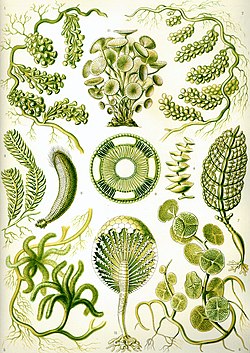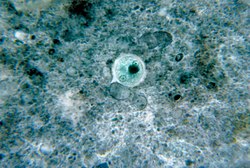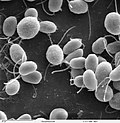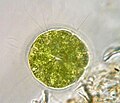Pyrenoids are sub-cellular phase-separated micro-compartments found in chloroplasts of many algae, and in a single group of land plants, the hornworts...
28 KB (3,564 words) - 04:30, 17 January 2025
and traditionally has been distinguished mainly through the absence of a pyrenoid. Species of Chloromonas occupy a variety of habitats, including soil, temporary...
6 KB (545 words) - 21:42, 29 November 2024
Chloroplast (section Pyrenoids)
Starch can also accumulate around the pyrenoids when CO2 is scarce. Pyrenoids can divide to form new pyrenoids, or be produced "de novo". Thylakoids (sometimes...
193 KB (19,591 words) - 05:38, 8 May 2025
autospores. Each cell contains a single chloroplast, a variable number of pyrenoids (including lack thereof), and from one to hundreds of flagella without...
48 KB (4,809 words) - 03:03, 5 May 2025
and compressed. Cells contain a cup-shaped chloroplast with one or more pyrenoids and usually an stigma. Two contractile vacuoles are present at the base...
3 KB (307 words) - 21:20, 1 April 2025
worldwide. The species name pyrenoidosa refers to the presence of a prominent pyrenoid within the Chlorella chloroplast. Auxenochlorella pyrenoidosa has been...
4 KB (372 words) - 13:56, 10 April 2025
single chloroplast which contains a central pyrenoid surrounded by grains of starch, as well as another pyrenoid (called the pseudopyrenoid) near the edge...
5 KB (431 words) - 20:08, 26 February 2025
reticulate, cup-shaped, spiral, or ribbon shaped. They have one or more pyrenoids to preserve protein and starch. The latter chlorophyll type is not known...
97 KB (11,195 words) - 13:51, 18 May 2025
of the monoplastidic species, a cellular structure called a pyrenoid is absent. The pyrenoid is a liquid-like organelle which enables a more efficient photosynthesis...
31 KB (3,170 words) - 18:26, 25 March 2025
chloroplast is parietal and plate-like, at one or both ends, and with one naked pyrenoid. Guiry, M.D. & Guiry, G.M. (2007). "Genus: Nannochloris taxonomy browser"...
2 KB (142 words) - 02:46, 2 February 2025
of RuBisCO is densely packed into a single subcellular compartment: the pyrenoid. Carbon dioxide is concentrated in this compartment using a combination...
27 KB (3,117 words) - 18:08, 19 February 2025
Meiosis in protists Gametic Zygotic Sporic Other Cyst Cytostome Fimbriae Extrusome Contractile vacuole Eyespot apparatus Pyrenoid Axostyle Mastigont system...
20 KB (2,512 words) - 04:42, 4 December 2024
be stored as starch granules and paramylon. Paramylon is made in the pyrenoids of Euglena. The euglenoids have chlorophylls a and b and they store their...
3 KB (264 words) - 23:32, 12 March 2025
the cell. Pyrenoids are normally present, but in some conditions (such as in photoheterotrophic medium), some species do not produce pyrenoids. At the center...
10 KB (917 words) - 05:33, 29 March 2025
there is a large thick central piece containing a single large pyrenoid. From the pyrenoid, there are many irregularly arranged lobes that branch out to...
2 KB (160 words) - 21:35, 24 December 2023
intensely-colored green chloroplast, their flagellated cell bodies, the presence of a pyrenoid within the chloroplast, and a scale-produced thecal-wall. Species within...
19 KB (2,430 words) - 17:08, 11 May 2025
accumulate within the cell from where they diffuse into the carboxysomes. Pyrenoids in algae and hornworts also act to concentrate CO2 around RuBisCO. The...
110 KB (11,815 words) - 15:05, 14 April 2025
membranes Thylakoid, site of the light-dependent reactions of photosynthesis Pyrenoid, center of carbon fixation Nucleus Lysosome, holds enzymes Phagocytic vacuole...
18 KB (1,517 words) - 02:09, 5 May 2025
mucilage. Cells contain a single cup-shaped, parietal chloroplast with one pyrenoid. Chlorococcum reproduces by the formation of autospores or zoospores. The...
6 KB (538 words) - 21:25, 29 November 2024
one to three mitochondria, a nucleus, a vacuole, and floridean starch. Pyrenoids are absent. Most are extremophiles inhabiting acid hot springs with a...
6 KB (598 words) - 21:52, 20 April 2025
hydroxyproline-rich glycoproteins, a large cup-shaped chloroplast, a large pyrenoid, and an eyespot apparatus that senses light. Chlamydomonas species are...
35 KB (3,874 words) - 03:42, 9 January 2025
base, an eyespot, and a large cup-shaped chloroplast with at least one pyrenoid. The colonies co-ordinate their flagellar movement to create a rolling...
7 KB (707 words) - 00:08, 17 April 2025
vacuoles, and one cup-shaped, parietal chloroplast and a distinct stigma and pyrenoid. The chloroplast may be perforate, separated into segments. Asexual reproduction...
3 KB (309 words) - 18:18, 19 March 2025
through a pore of the cell wall (CW) from a walled amoeboid cell. Py: pyrenoid. Scale bar = 10 μm Binary and quaternary cell divisions of Lotharella globosa...
14 KB (968 words) - 09:48, 30 October 2024
by the lack of a pyrenoid in the chloroplast. This characteristic is unclear as some sources list Didymocystis as having pyrenoids, but some species...
3 KB (283 words) - 05:21, 23 February 2025
single chloroplast is present, filling nearly the entire cell; it lacks a pyrenoid. It is commonly used as a bioindicator species to assess the levels of...
3 KB (310 words) - 12:56, 15 April 2024
this genus is characterized by its unique lobed chloroplast that lacks a pyrenoid, differentiating it from other unicellular red algae. It has drawn interest...
5 KB (628 words) - 03:11, 18 May 2025
presence of pyrenoids is used as an identifying feature of the genus, separating it from other euglenoids, such as Lepocinclis and Phacus. Pyrenoids may be...
35 KB (3,679 words) - 16:25, 11 May 2025
flagella are present. The chloroplast is variable in shape, and a both a pyrenoid and stigma may be present or absent; some taxa are colorless and lack chloroplasts...
4 KB (363 words) - 01:56, 23 March 2025
g. Prasiola), numerous and discoid (e.g. Eremosphaera), or parietal. Pyrenoids may be present or absent. In most species, reproduction occurs exclusively...
22 KB (2,326 words) - 13:38, 24 February 2025























